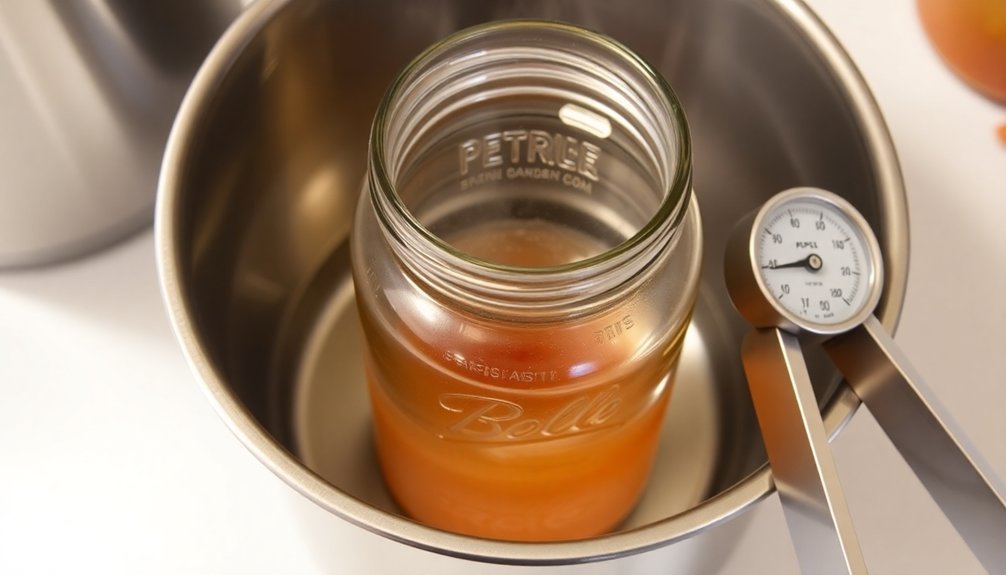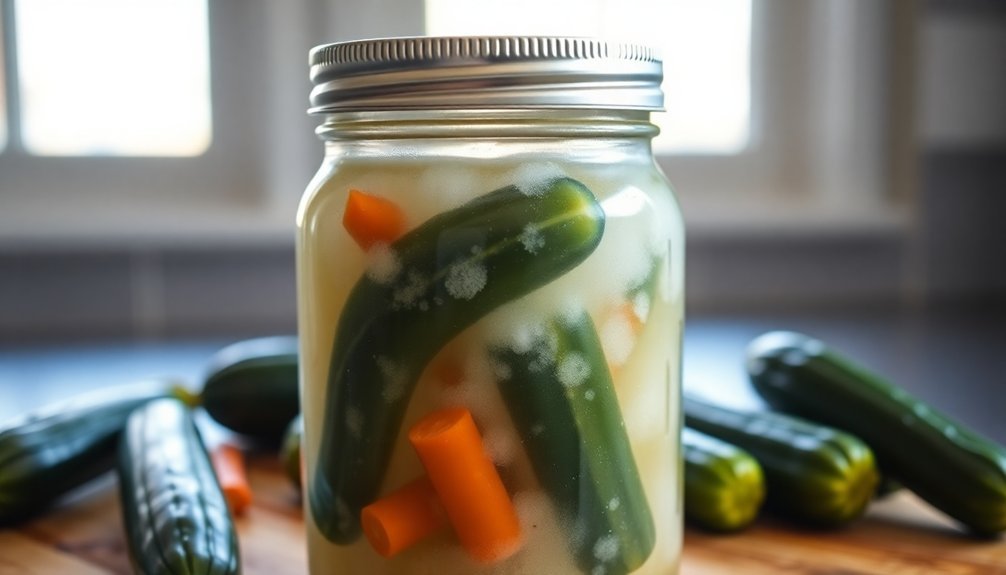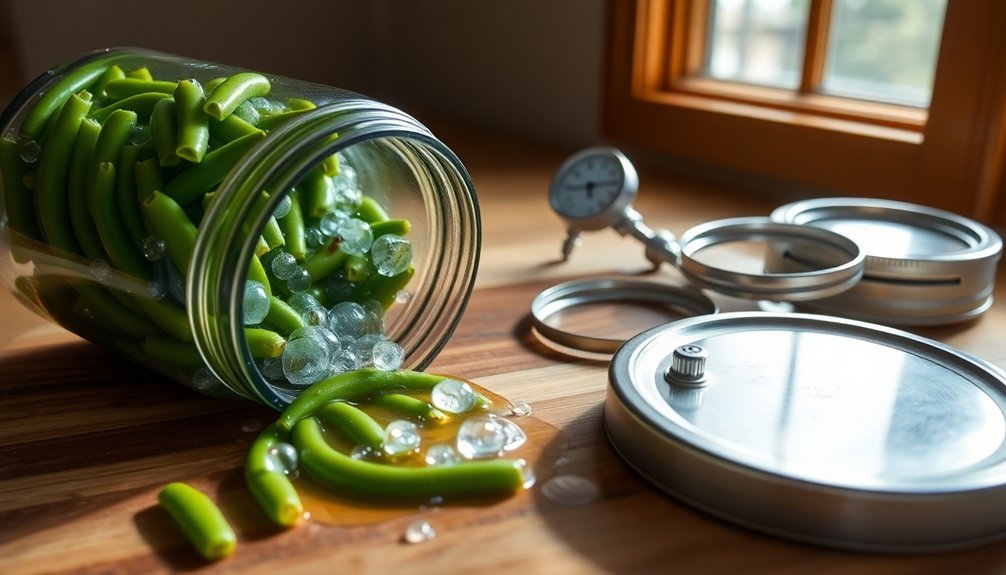To safely preserve vegetables and prevent deadly botulism, you'll need to follow five essential safety protocols. Always use pressure canning for low-acid vegetables at 240°F, as boiling water canning isn't safe for these foods. Maintain your pressure canner by regularly checking gauges, gaskets, and vents for proper function. Store preserved foods in cool, dry places below 40°F, and immediately discard any containers showing signs of damage or bulging. Remember that botulinum toxin has no taste or smell, so you can't detect it by examining the food. Understanding these critical requirements will help guarantee your home preservation efforts remain safe and successful.
Choose Safe Preserving Methods

When preserving vegetables at home, choosing the right preservation method is essential for food safety.
You'll need to carefully match each vegetable with the appropriate preservation technique based on its acidity level and composition. For low-acid vegetables, don't use boiling water canners, as they won't reach the necessary temperature to prevent botulism. Pressure canners reaching 240°F are required for safely preserving low-acid vegetables.
Always follow USDA guidelines and use only tested recipes from reliable sources. Before starting, check the pH level of your vegetables. If it's above 4.6, you'll need to acidify them with vinegar or lemon juice before preservation. This is particularly important for foods like pickles and salsa.
You've got several safe options for preserving vegetables. For short-term storage, refrigeration works well for leafy greens and cucumbers.
Pickling is effective when you properly acidify vegetables in a vinegar-based brine. If you're interested in dehydration, remove all moisture and store the dried vegetables in airtight containers.
Fermentation using saltwater brine can be safe when done correctly. For root vegetables like potatoes and carrots, proper ventilation in a cool, dark space is vital.
Remember to discard any preserved vegetables that show signs of spoilage, such as bulging or leaking containers.
Pressure Canner Temperature Requirements
Through the precise control of temperature, pressure canning guarantees the safety of low-acid vegetables by reaching the critical 240-250°F range needed to destroy harmful bacteria.
Utilize approved canners designed specifically for home food preservation to ensure proper pressure control and safety.
You'll need to maintain this temperature range to effectively eliminate Clostridium botulinum spores, which can't be destroyed at the lower temperatures achieved in water bath canning.
You must process your vegetables at the correct pressure setting, typically 10 pounds, though this can vary based on your altitude and the specific food you're preserving.
If you're canning above 1,000 feet elevation, you'll need to adjust both pressure and processing time since water boils at lower temperatures at higher altitudes.
Key safety requirements you must follow:
- Never reduce the recommended processing time or pressure, as this can leave deadly botulism spores alive
- Always check altitude-specific guidelines for proper pressure settings
- Monitor your pressure gauge carefully throughout the entire processing time
- Use only tested recipes from reliable sources that specify exact pressure and time requirements
Proper Equipment Maintenance

Proper maintenance of your pressure canner and its components is essential for both safety and longevity. After each use, clean your canner with hot soapy water, being careful not to submerge the dial gauge if your model has one.
You'll need to pay special attention to the vent and safety valve by pulling a clean string or cloth strip through them to remove any debris. Your canner should be UL approved for maximum safety assurance.
Don't forget to examine your rubber gasket regularly. It should be flexible and soft, not brittle or cracked. If you notice any signs of wear, replace it immediately.
Clean the gasket as needed and store it in a dry place to prevent deterioration.
To prevent corrosion, remove and clean ring bands after use, and tackle any dark deposits inside aluminum canners with a cream of tartar and water solution.
When you're storing your canner, place it with the lid upside down and unsealed. Add clean paper towels in the bottom to absorb moisture and odors.
Keep your equipment in a dry, well-ventilated area, and always follow the manufacturer's specific storage guidelines to maintain peak performance.
Storage and Quality Control
Safe storage of preserved vegetables requires consistent temperature control and careful monitoring. You'll need to maintain refrigerated foods at 40°F (4°C) or below to prevent bacterial growth and toxin formation.
When storing canned goods, keep them in a cool, dry place to avoid temperature fluctuations that could compromise their safety.
For proper storage and quality control, follow these essential guidelines:
- Never store produce in airtight containers, as this can create anaerobic conditions that promote C. botulinum growth. Instead, use vented packaging for high-respiration items like mushrooms.
- Check your refrigerator's temperature regularly with a calibrated thermometer to guarantee it maintains safe temperatures consistently.
- Discard any canned goods showing signs of compromise, such as bulging lids, leaks, cracks, or unusual spurting when opened.
- Store foil-wrapped baked potatoes at 140°F or above if serving hot, or refrigerate them immediately with loosened foil.
When handling home-canned vegetables, you must boil them for 10 minutes before serving, adding an extra minute for each 1,000 feet of elevation.
If you're ever in doubt about a preserved food's safety, don't taste it to check – simply throw it out.
Warning Signs and Risks

Understanding warning signs for food spoilage builds upon proper storage practices, but the most dangerous contaminant – botulinum toxin – can't be detected by sight, smell, or taste.
Even a tiny amount of this toxin can be lethal, with just one teaspoon capable of killing 100,000 people. You can't rely on visual cues or odors to determine if your preserved foods are safe.
Your greatest risks come from low-acid foods like vegetables, meats, fish, and some tomatoes, particularly when they're home-canned.
You'll need to be especially careful with vegetables, as they're the leading cause of botulism outbreaks in the U.S. Don't trust boiling water canning for these items – you must use pressure canning methods to guarantee safety.
Watch out for specific high-risk situations: never leave foil-wrapped baked potatoes at room temperature, and don't store garlic or herbs in oil unless you'll use them within four days under refrigeration.
If you're fermenting vegetables or fish, you'll need to confirm they reach proper acidity levels.
Frequently Asked Questions
Can I Reuse Canning Lids From Previous Batches?
No, you shouldn't reuse canning lids. They're designed for single use only, as the sealing compound won't work properly a second time. Always use new lids to guarantee your food stays safely preserved.
What Happens if Power Fails During Pressure Canning?
If your power fails during pressure canning, don't open the canner. Let it cool naturally, then reprocess your food for the full recommended time once power's restored. You'll need to start the process over completely.
How Long Can I Keep an Unopened Jar of Home-Canned Vegetables?
You can keep properly stored home-canned vegetables for 1-2 years, though they'll often stay good for up to 5 years. Store them in a cool, dark place and always check for signs of spoilage before eating.
Should Vegetables Be Raw or Precooked Before Pressure Canning?
You can use either raw or precooked vegetables for pressure canning. While precooking isn't necessary, some recipes may specify it. Just remember that you'll still need to process them in the pressure canner regardless.
Can I Adjust Canning Recipes for High-Altitude Locations?
Yes, you'll need to adjust your canning recipes for higher altitudes. Add extra processing time for water bath canning and increase pressure for pressure canning. Check your specific altitude to make proper adjustments.
In Summary
Don't take chances with home food preservation – botulism can be deadly. If you're following these safety guidelines, you'll greatly reduce your risk while preserving vegetables. Always use proper equipment, maintain correct pressure and temperature, and store your preserved foods correctly. Watch for warning signs like bulging lids or odd smells. When in doubt, throw it out – your family's safety isn't worth the risk.





Leave a Reply